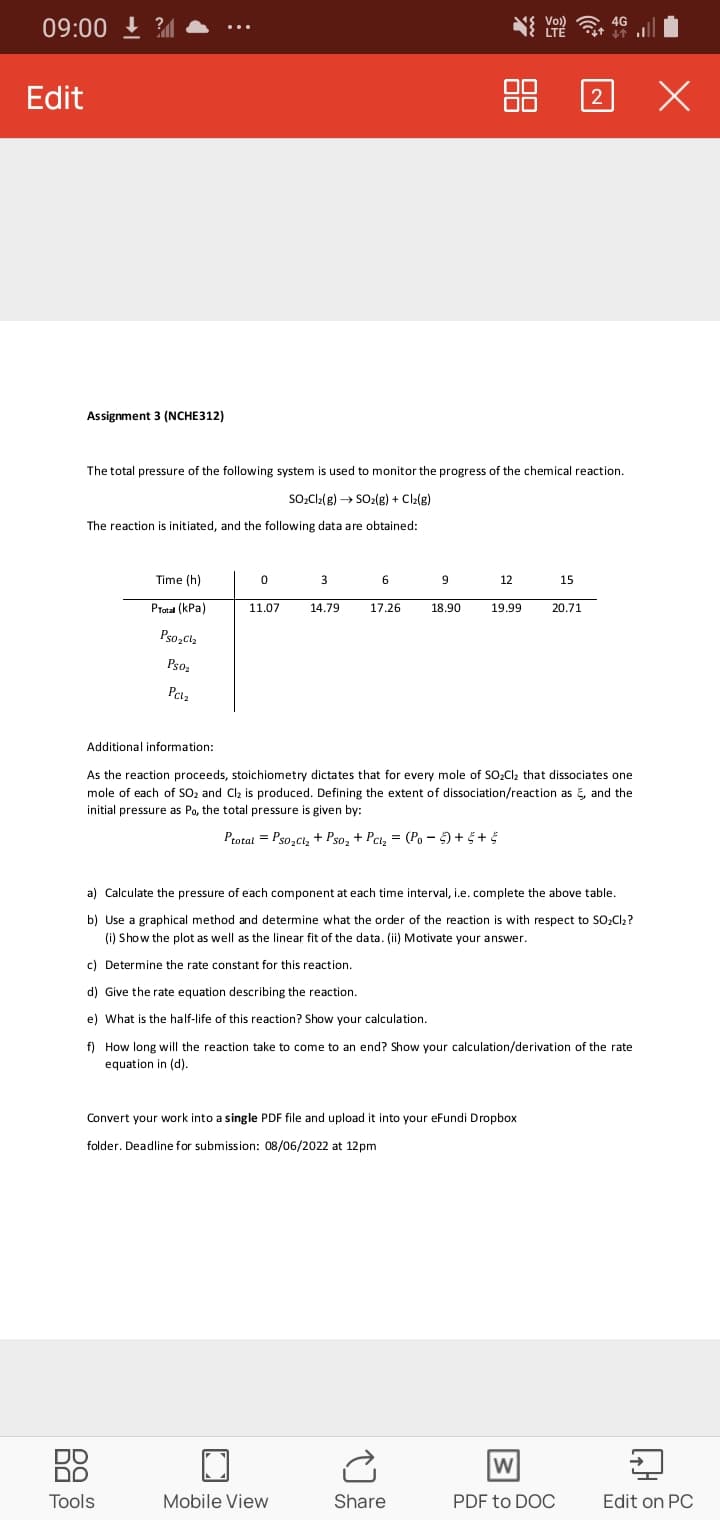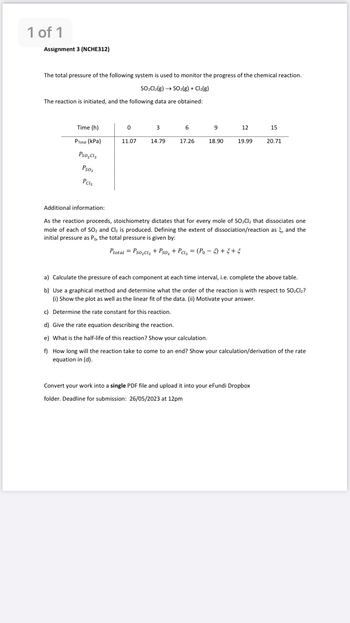The total pressure of the following system is used to monitor the progress of the chemical reaction. SO₂Cl₂(g) → SO₂(g) + Cl₂(g) The reaction is initiated, and the following data are obtained: Time (h) 0 3 6 9 12 15 11.07 14.79 17.26 PTotal (kPa) 18.90 19.99 20.71 Pso₂Cl₂ Pso₂ Pctz Additional information: As the reaction proceeds, stoichiometry dictates that for every mole of SO₂Cl₂ that dissociates one mole of each of SO₂ and Cl₂ is produced. Defining the extent of dissociation/reaction as , and the initial pressure as Po, the total pressure is given by: Ptotal = Pso₂Cl₂ + Pso₂+ Pct₂ = (Po-5)+ 5 + 5 a) Calculate the pressure of each component at each time interval, i.e. complete the above table. b) Use a graphical method and determine what the order of the reaction is with respect to SO₂Cl₂? (i) Show the plot as well as the linear fit of the data. (ii) Motivate your answer. c) Determine the rate constant for this reaction. d) Give the rate equation describing the reaction. e) What is the half-life of this reaction? Show your calculation. f) How long will the reaction take to come to an end? Show your calculation/derivation of the rate equation in (d).
The total pressure of the following system is used to monitor the progress of the chemical reaction. SO₂Cl₂(g) → SO₂(g) + Cl₂(g) The reaction is initiated, and the following data are obtained: Time (h) 0 3 6 9 12 15 11.07 14.79 17.26 PTotal (kPa) 18.90 19.99 20.71 Pso₂Cl₂ Pso₂ Pctz Additional information: As the reaction proceeds, stoichiometry dictates that for every mole of SO₂Cl₂ that dissociates one mole of each of SO₂ and Cl₂ is produced. Defining the extent of dissociation/reaction as , and the initial pressure as Po, the total pressure is given by: Ptotal = Pso₂Cl₂ + Pso₂+ Pct₂ = (Po-5)+ 5 + 5 a) Calculate the pressure of each component at each time interval, i.e. complete the above table. b) Use a graphical method and determine what the order of the reaction is with respect to SO₂Cl₂? (i) Show the plot as well as the linear fit of the data. (ii) Motivate your answer. c) Determine the rate constant for this reaction. d) Give the rate equation describing the reaction. e) What is the half-life of this reaction? Show your calculation. f) How long will the reaction take to come to an end? Show your calculation/derivation of the rate equation in (d).
Chemistry for Engineering Students
4th Edition
ISBN:9781337398909
Author:Lawrence S. Brown, Tom Holme
Publisher:Lawrence S. Brown, Tom Holme
Chapter11: Chemical Kinetics
Section: Chapter Questions
Problem 11.58PAE
Related questions
Question

Transcribed Image Text:09:00
Edit
סם
⠀
2
Assignment 3 (NCHE312)
The total pressure of the following system is used to monitor the progress of the chemical reaction.
SO₂Cl2(g) → SO₂(g) + Cl₂(g)
The reaction is initiated, and the following data are obtained:
0
3
6
9
12
15
Time (h)
PTotal (kPa)
14.79
17.26
18.90
11.07
19.99
20.71
Pso₂Cl₂
Pso₂
Pclz
Additional information:
As the reaction proceeds, stoichiometry dictates that for every mole of SO₂Cl₂ that dissociates one
mole of each of SO₂ and Cl₂ is produced. Defining the extent of dissociation/reaction as E, and the
initial pressure as Po, the total pressure is given by:
Ptotal = Pso₂Cl₂ + Ps0₂ + Pcl₂ = (Po-5 + 5 + 5
a) Calculate the pressure of each component at each time interval, i.e. complete the above table.
b) Use a graphical method and determine what the order of the reaction is with respect to SO₂Cl₂?
(i) Show the plot as well as the linear fit of the data. (ii) Motivate your answer.
c) Determine the rate constant for this reaction.
d) Give the rate equation describing the reaction.
e) What is the half-life of this reaction? Show your calculation.
f) How long will the reaction take to come to an end? Show your calculation/derivation of the rate
equation in (d).
Convert your work into a single PDF file and upload it into your eFundi Dropbox
folder. Deadline for submission: 08/06/2022 at 12pm
DO
W
Mobile View
Share
PDF to DOC
Tools
Vol)
LTE
4G
x
HJ
Edit on PC
Expert Solution
This question has been solved!
Explore an expertly crafted, step-by-step solution for a thorough understanding of key concepts.
This is a popular solution!
Trending now
This is a popular solution!
Step by step
Solved in 6 steps with 1 images

Follow-up Questions
Read through expert solutions to related follow-up questions below.
Follow-up Question
#(d)Give the rate equation describing the reaction.
#(e)What is the half life of this reaction?Show your calculations.
#(f) How long will the reaction take to come to an end? Show your calculations/derivation of the rate equation in (d).
Solution
Follow-up Question

Transcribed Image Text:1 of 1
Assignment 3 (NCHE312)
The total pressure of the following system is used to monitor the progress of the chemical reaction.
SO₂Cl₂(g) → SO2(g) + Cl₂(g)
The reaction is initiated, and the following data are obtained:
Time (h)
PTotal (kPa)
Pso₂cl₂
Ps0₂
Pclz
0
11.07
3
6
14.79 17.26
9
18.90
12
19.99
15
20.71
Additional information:
As the reaction proceeds, stoichiometry dictates that for every mole of SO₂Cl₂ that dissociates one
mole of each of SO₂ and Cl₂ is produced. Defining the extent of dissociation/reaction as E, and the
initial pressure as Po, the total pressure is given by:
Ptotal = Pso₂Cl₂ + Pso₂+ Pcl₂ = (Po-5)+5+5
Convert your work into a single PDF file and upload it into your eFundi Dropbox
folder. Deadline for submission: 26/05/2023 at 12pm
a) Calculate the pressure of each component at each time interval, i.e. complete the above table.
b) Use a graphical method and determine what the order of the reaction is with respect to SO₂Cl₂?
(i) Show the plot as well as the linear fit of the data. (ii) Motivate your answer.
c) Determine the rate constant for this reaction.
d) Give the rate equation describing the reaction.
e) What is the half-life of this reaction? Show your calculation.
f) How long will the reaction take to come to an end? Show your calculation/derivation of the rate
equation in (d).
Solution
Knowledge Booster
Learn more about
Need a deep-dive on the concept behind this application? Look no further. Learn more about this topic, chemistry and related others by exploring similar questions and additional content below.Recommended textbooks for you

Chemistry for Engineering Students
Chemistry
ISBN:
9781337398909
Author:
Lawrence S. Brown, Tom Holme
Publisher:
Cengage Learning

General Chemistry - Standalone book (MindTap Cour…
Chemistry
ISBN:
9781305580343
Author:
Steven D. Gammon, Ebbing, Darrell Ebbing, Steven D., Darrell; Gammon, Darrell Ebbing; Steven D. Gammon, Darrell D.; Gammon, Ebbing; Steven D. Gammon; Darrell
Publisher:
Cengage Learning


Chemistry for Engineering Students
Chemistry
ISBN:
9781337398909
Author:
Lawrence S. Brown, Tom Holme
Publisher:
Cengage Learning

General Chemistry - Standalone book (MindTap Cour…
Chemistry
ISBN:
9781305580343
Author:
Steven D. Gammon, Ebbing, Darrell Ebbing, Steven D., Darrell; Gammon, Darrell Ebbing; Steven D. Gammon, Darrell D.; Gammon, Ebbing; Steven D. Gammon; Darrell
Publisher:
Cengage Learning


Chemistry: An Atoms First Approach
Chemistry
ISBN:
9781305079243
Author:
Steven S. Zumdahl, Susan A. Zumdahl
Publisher:
Cengage Learning

Chemistry
Chemistry
ISBN:
9781305957404
Author:
Steven S. Zumdahl, Susan A. Zumdahl, Donald J. DeCoste
Publisher:
Cengage Learning

Principles of Modern Chemistry
Chemistry
ISBN:
9781305079113
Author:
David W. Oxtoby, H. Pat Gillis, Laurie J. Butler
Publisher:
Cengage Learning